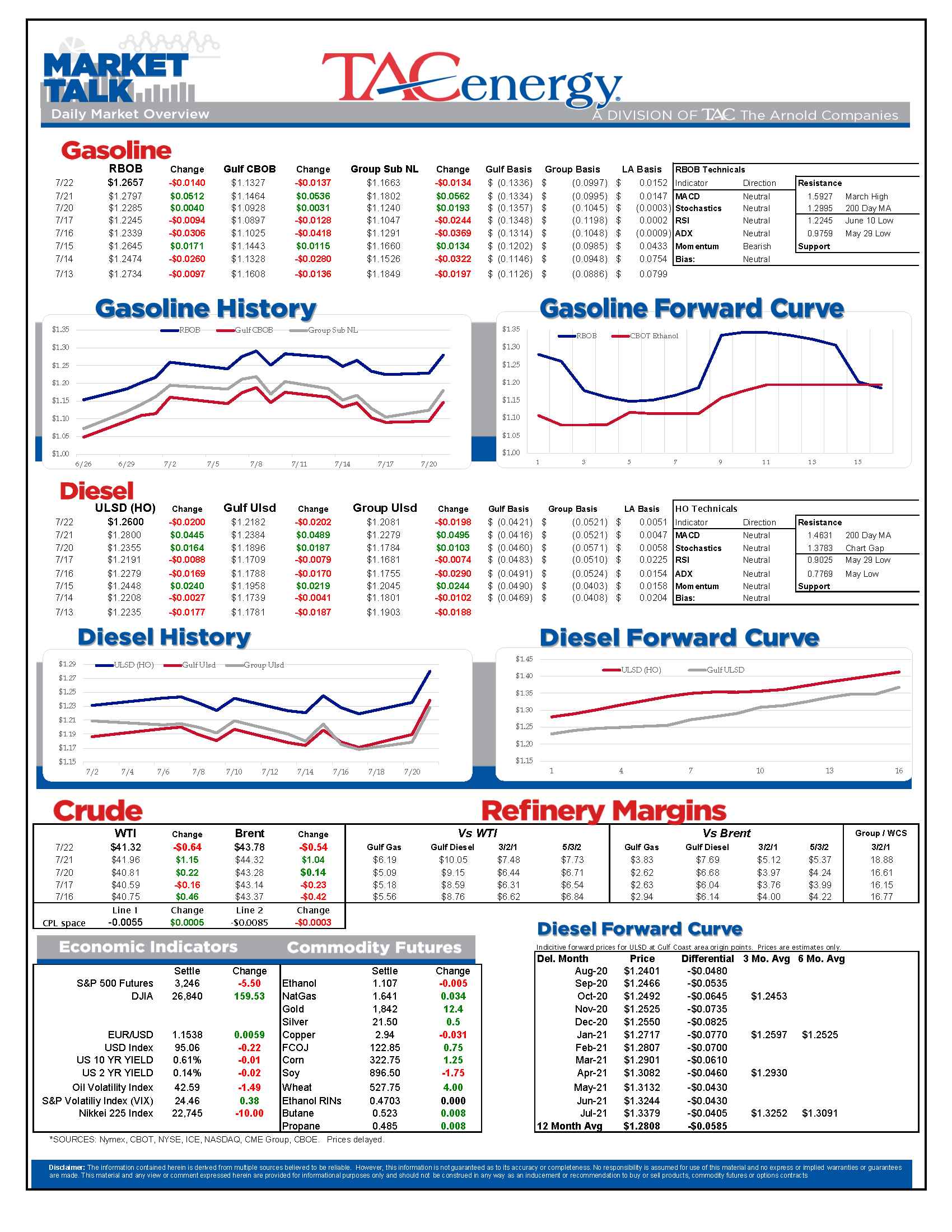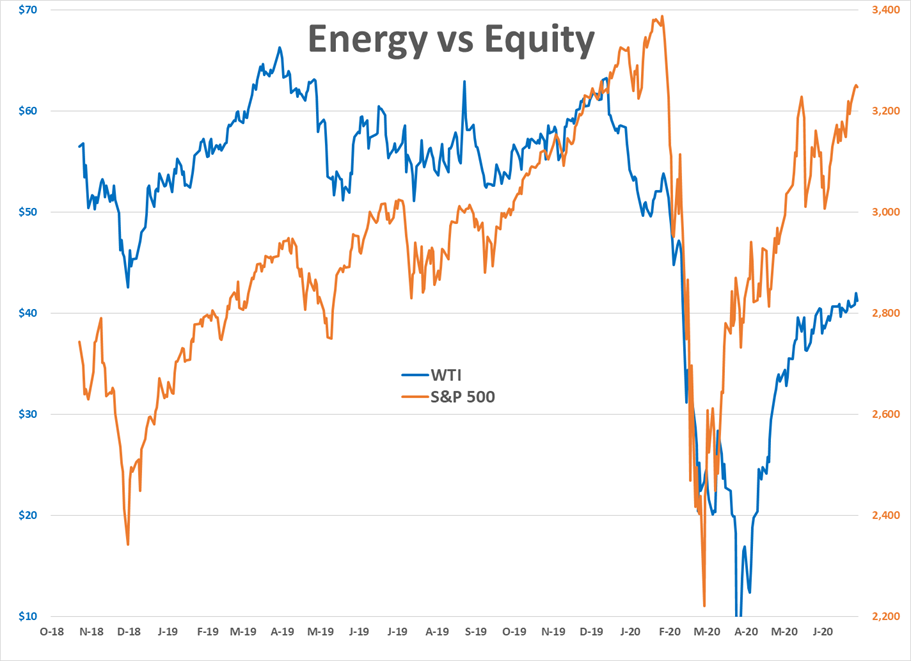Energy Prices Pull Back To Start Wednesday's Session

Energy prices are pulling back to start Wednesday’s session after WTI, ULSD and the S&P 500 all hit new four-month highs Tuesday. Yesterday’s gains were fueled by optimism after European leaders worked out a stimulus package agreement, while today’s selling is being blamed on the latest dust up between the world’s two largest consumers.
The U.S. ordered China to close its consulate in Houston due to intellectual property concerns, which caused China to threaten retaliation. Video of people burning documents in the courtyard of the consulate adds to the intrigue of this event, as does the Houston location which happens to be the heart of the U.S. energy industry, although if the issue is related to energy markets in any way.
The API was reported to show a build in crude oil stocks of 7.5 million barrels last week – which is also getting credit for some of the early selling in energy futures – even though gasoline and diesel stocks both saw inventories decline by two million and 1.3 million barrels, respectively. The DOE’s weekly report is due out at its normal time this morning.
From a technical perspective, if WTI can weather this latest storm and hold above $41 and ULSD can hold above $1.24, the charts suggest more room to run to the upside, with the first big test at the 200 day MA for WTI just above $43. If prices fail to hold above those levels however, it seems we may return to the aimless sideways pattern that’s held prices for all of July. RBOB futures have been unable to keep up with ULSD and WTI lately, failing several times just below the 200 day moving average over the past four weeks, as buyers seem cautious to bet on higher gasoline prices now that the peak of driving season is in the rear-view mirror.
It’s already been a record setting season for tropical storm systems in the Atlantic, and now there are two more threats this week. One system in the Gulf of Mexico is given a 40 percent chance of development by the NHC as it heads towards the Texas coast, while another is expected to become Tropical Storm Gonzalo as it makes it way to the Caribbean, and could become a Gulf Coast threat next week.
Click here to download a PDF of today's TACenergy Market Talk.
Latest Posts
Week 17 - US DOE Inventory Recap
The Energy Complex Is Trading Modestly Lower So Far This Morning With WTI Crude Oil Futures Leading The Way
Energy Futures Are Drifting Quietly Higher This Morning
Refined Products Holding Close To Break Even While Oil Prices Are Losing Just Under 1%
Social Media
News & Views
View All
Week 17 - US DOE Inventory Recap

The Energy Complex Is Trading Modestly Lower So Far This Morning With WTI Crude Oil Futures Leading The Way
The energy complex is trading modestly lower so far this morning with WTI crude oil futures leading the way, exchanging hands $1.50 per barrel lower (-1.9%) than Tuesday’s settlement price. Gasoline and diesel futures are following suit, dropping .0390 and .0280 per gallon, respectively.
A surprise crude oil build (one that doesn’t include any changes to the SPR) as reported by the American Petroleum Institute late Tuesday is taking credit for the bearish trading seen this morning. The Institute estimated an increase in crude inventories of ~5 million barrels and drop in both refined product stocks of 1.5-2.2 million barrels for the week ending April 26. The Department of Energy’s official report is due out at it’s regular time (9:30 CDT) this morning.
The Senate Budget Committee is scheduled to hold a hearing at 9:00 AM EST this morning regarding a years-long probe into climate change messaging from big oil companies. Following a 3-year investigation, Senate and House Democrats released their final report yesterday alleging major oil companies have internally recognized the impacts of fossil fuels on the climate since as far back as the 1960s, while privately lobbying against climate legislation and publicly presenting a narrative that undermines a connection between the two. Whether this will have a tangible effect on policy or is just the latest announcement in an election-yeardeluge is yet to be seen.
Speaking of deluge, another drone attack was launched against Russian infrastructure earlier this morning, causing an explosion and subsequent fire at Rosneft’s Ryazan refinery. While likely a response to the five killed from Russian missile strikes in Odesa and Kharkiv, Kyiv has yet to officially claim responsibility for the attack that successfully struck state infrastructure just 130 miles from Moscow.
The crude oil bears are on a tear this past week, blowing past WTI’s 5 and 10 day moving averages on Monday and opening below it’s 50-day MA this morning. The $80 level is likely a key resistance level, below which the path is open for the American oil benchmark to drop to the $75 level in short order.
Click here to download a PDF of today's TACenergy Market Talk.

Energy Futures Are Drifting Quietly Higher This Morning
Energy futures are drifting quietly higher this morning as a new round of hostage negotiations between Israel and Hamas seem to show relative promise. It seems the market is focusing on the prospect of cooler heads prevailing, rather than the pervasive rocket/drone exchanges, the latest of which took place over Israel’s northern border.
A warmer-than-expected winter depressed diesel demand and, likewise, distillate refinery margins, which has dropped to its lowest level since the beginning of 2022. The ULSD forward curve has shifted into contango (carry) over the past month as traders seek to store their diesel inventories and hope for a pickup in demand, domestic or otherwise.
The DOE announced it had continued rebuilding it’s Strategic Petroleum Reserve this month, noting the addition of 2.3 million barrels of crude so far in April. Depending on what the private sector reported for last week, Wednesday’s DOE report may put current national crude oil inventories (include those of the SPR) above the year’s previous levels, something we haven’t seen since April of 2022, two months after Ukraine war began.
The latest in the Dangote Refinery Saga: Credit stall-out, rising oil prices, and currency exchange.
Click here to download a PDF of today's TACenergy Market Talk.


